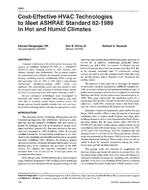Description
Computer simulations were performed to investigate the impacts of ASHRAE Standard 62-1989 on a 100,000-ft2 (9,290-m2) office building located in three Florida cities (Miami, Orlando, and Jacksonville). The increased outdoor air requirements prescribed by the standard increased annual heating, ventilating, and air conditioning (HVAC) energy use and operating costs by 10% to 15% when a conventional chilled-water variable-air-volume (VAV) system was employed. The conventional system was also unable to meet the increased latent load, resulting in elevated indoor humidity levels (i.e., numerous hours with relative humidity more than 60%). Several alternative technologies were investigated to determine their ability to mitigate these impacts, and some were able to maintain proper indoor humidity levels. The design engineer should carefully consider the costs and benefits of each technology before selecting the appropriate system.
KEYWORDS: year 1996, costs, economics, tropics, subtropics, calculating, standards, ventilation, energy consumption, variable volume air conditioning, relative humidity, humidity, comparing, demand controlled ventilation, heat recovery, USA, energy storage, ice storage, service life
Citation: ASHRAE Trans. 1996, vol.102, part 1, paper number 3949, 166-182, 12 figs., 5 tabs., refs.
Product Details
- Published:
- 1996
- File Size:
- 1 file , 1.9 MB
- Product Code(s):
- D-16525




